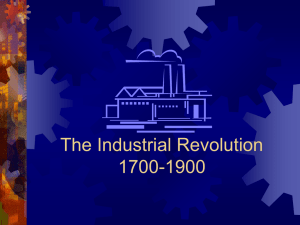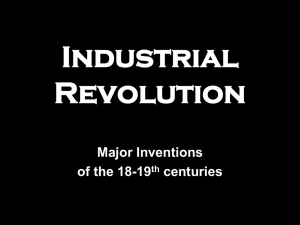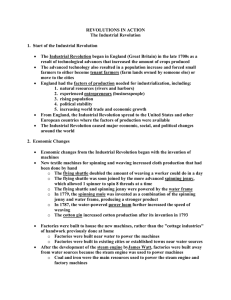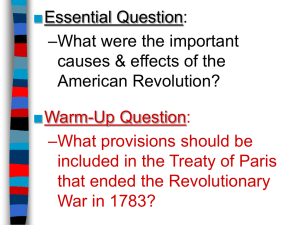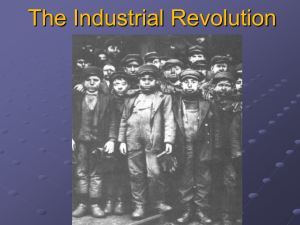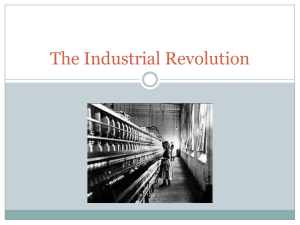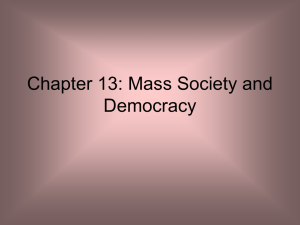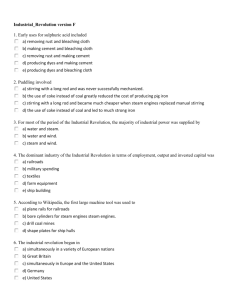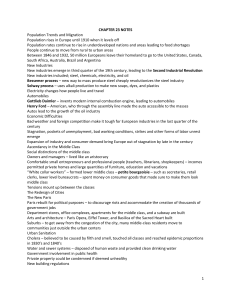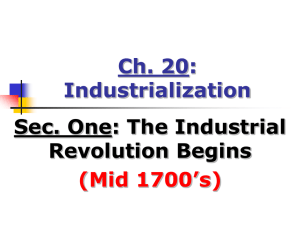The Industrial Revolution
advertisement
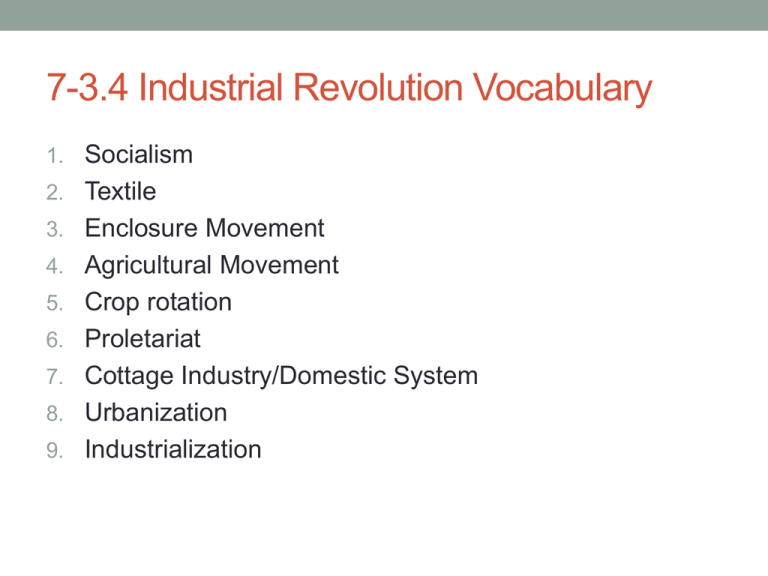
7-3.4 Industrial Revolution Vocabulary 1. Socialism 2. Textile 3. Enclosure Movement 4. Agricultural Movement 5. Crop rotation 6. Proletariat 7. Cottage Industry/Domestic System 8. Urbanization 9. Industrialization THE INDUSTRIAL REVOLUTION Standard 7-3.4 1. The Beginning The industrial revolution started with the Agricultural Revolution and early advancements in farming. (Crop Rotation, Seed Drill, Selective Breeding) B. The agricultural revolution led to a population increase C. This forced small farmers to become tenant farmers (farmers who worked someone else’s land), or move into the cities. A. 2. Seeds for Industrialism Great Britain was in a great location to industrialize. B. It had access to natural resources as well as rivers and harbors C. The people were experienced entrepreneurs D. Great Britain had experienced a time of stability and growth. A. 3. Economic Revolution The industrial revolution had widespread effects on the economy. The Revolution began with the invention of machines. B. New textile machines for weaving and spinning that had been done by hand was now being done in a factory (end of the cottage system) A. 4. New Technologies The flying shuttle revolutionized the textile production process. It doubled the amount of weaving a worker could do in one day. B. The Spinning Jenny allowed a worker to spin eight threads at once, then came improved tools: water powered loom, water frame, spinning mule. C. Water power allowed the machines to work at a much faster pace. D. The Cotton Gin, invented by Eli Whitney, allowed for much faster processing of cotton, and therefore an increased amount of textiles. A. 5. Relocation Because of the need for water power, factories were built along rivers and streams. B. Jobs that people had done in the home were relocated to these places where they could be done cheaper and faster. C. With the invention of the steam engine factories could be built anywhere, but the cottage industry was over. A. 6. Changes in Transportation The steam engine created a huge increase in new forms of transportation B. Steamboats, and steam powered locomotives were constructed, creating a need for canals and railway lines C. Coal was needed to power these machines – increase in mining/miners D. Inexpensive travel meant wider distribution of goods. A. 7. Dividing things Up A. B. C. D. E. The factory system led to standardization of construction. Interchangeable parts were used, allowing people to switch out broken parts of an item for working ones without scrapping the entire piece. Workers were assigned specific tasks, which increased productivity and decreased worker training times Mass production allowed for goods to be built at a cheaper price. More money was to be made in factories than on farms, this led to people flocking to the cities. 8. Rural to Urban Movement When people moved from the farms into the cities there were many social changes. Many cities doubled in size! B. Low pay and living conditions meant that the lower class often didn’t have basic needs, such as running water. C. The middle and upper classes moved into the suburbs, away from the filth of the cities. D. This led to an increase in class divisions. A. 9. Regulation of Industrialism Laissez-Faire capitalism, or “a hands off approach” to capitalism was what started the industrial revolution. B. This led to differences in the distribution of wealth as the rich got richer and the poor stayed poor. C. The working class was oppressed or held down by the upper class and felt socialism, or cooperative ownership of industry, was the right answer. A. 10. The ideas of socialism The workers felt socialism gave them more protection than capitalism. B. It promised to better distribute wealth to all people C. Karl Marx and Friedrich Engles wrote The Communist Manifesto stating that socieity was divided and the proletariat (the have nots) would overthrow the bourgeoisie (The haves). D. This revolution did not occur, but it inspired many people. A. 11. Labor Unions As a result of the conditions and unfair practices many workers formed labor unions. B. Unions were groups that worked together to get better working conditions, higher pay, and shorter working hours. They didn’t want to be taken advantage of anymore! C. Eventually they succeeded and in the 1830s British parliament allowed the first unions. A. 12. The Effects of Industrialization Once nations became industrialized, they started to look for cheap labor and resources. B. They started to look for weaker, non industrialized nations. C. This led to imperialism and a competition for resources! A.


